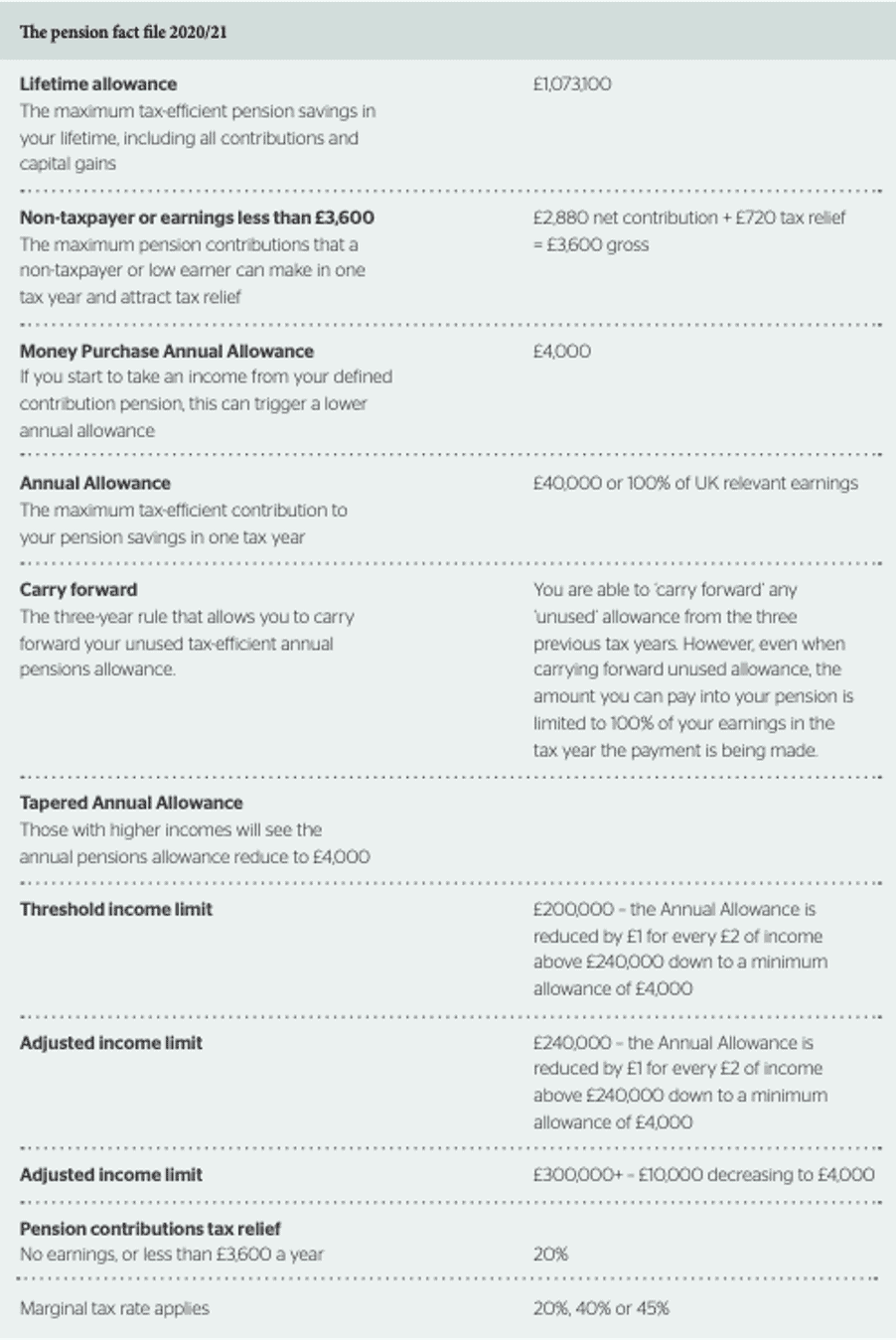The Pension Fact File 2020/21 - Tax Relief & Pension Allowances
Lifetime Allowance
All your pensions, including workplace pensions, count towards the Lifetime Allowance, with the exception of the State Pension and overseas pensions. The standard Lifetime Allowance is £1,073,100 since 6 April 2020 and increases with inflation each year. You don’t pay the tax charge until you take your pension savings over and above your Lifetime Allowance (or reach age 75, if earlier). The charge is only on the excess money saved in your pension that is above your Lifetime Allowance.
Non-taxpayer or earning less than £3,600
If you have no earnings or earn less than £3,600 a year, you can still pay into a pension scheme and qualify to receive tax relief added to your contributions up to a certain amount. The maximum you can contribute is £2,880 a year. Tax relief is added to your contributions, so if you pay £2,880, a total of £3,600 a year will be paid into your pension scheme, even if you earn less than this or have no income at all. This applies if you pay into a personal or stakeholder pension yourself (so not through an employer’s scheme) and with some workplace pension schemes – but not all. The way some workplace pension schemes give tax relief means that people earning less than the personal allowance (£12,500 in the 2020/21 tax year) won’t receive tax relief.
Money Purchase Annual Allowance
The Money Purchase Annual Allowance (MPAA) rules were introduced as an anti-avoidance measure to prevent wide-spread abuse of the pension freedoms which commenced from 6 April 2015. It’s intended to discourage individuals from diverting their salary into their pension with tax relief and then immediately withdrawing 25% tax-free. The MPAA applies only to money purchase contributions and has remained at £4,000 since 6 April 2017. If you have taken flexible benefits which include income, such as an ‘Uncrystallised Funds Pension Lump Sum (UFPLS)’ or flexi-access drawdown with income, and you want to continue making contributions to a defined contribution pension scheme, you will have a reduced annual allowance of £4,000 annually towards your defined contribution benefits.
Annual Allowance
The pension Annual Allowance is the maximum amount of money you can contribute towards a defined contribution pension scheme in a single tax year and receive tax relief on. All contributions made to your pension by you, your employer, or any third-party, as well as any tax relief received, count towards your Annual Allowance. The standard pension Annual Allowance is currently £40,000 or 100% of your income if you earn less than £40,000. A lower Annual Allowance may apply, however, if you are a high earner, or you have already started accessing your pension. High earners may potentially be subject to the Tapered Annual Allowance, while those who have already started accessing their pension potentially face the Money Purchase Annual Allowance (MPAA).
Carry forward
Carry forward is a way of increasing your pension Annual Allowance in the current tax year. It is used when your total pension contribution amounts for a tax year exceed your annual pension Annual Allowance limit for that year. You can do this by carrying forward unused allowances from the three previous tax years to make contributions this year. This may enable you to absorb or reduce any pension Annual Allowance excess paid in the current tax year which, in turn, would reduce any potential Annual Allowance charge amount. The 2020/21 tax year allows use of unused allowances from 2017/18, 2018/19 and 2019/20.
Tapered Annual Allowance
The Tapered Annual Allowance calculations will now not affect anyone with a Threshold Income level below £200,000. The taper starts in this tax year at £240,000 and extended to a minimum of £4,000 Annual Allowance. This reduces the level of pension funding high earners and their employers can make into pension schemes. If high earners exceed the threshold and adjusted income amounts, their Annual Allowance may be reduced by £1 for every £2 of adjusted income over this level until the minimum annual allowance level of £4,000 is reached. The maximum Tapered Annual Allowance reduction is £36,000.
Pension tax relief
The Government encourages you to save for your retirement by giving you tax relief on pension contributions. Tax relief has the effect of reducing your tax bill and/ or increasing your pension fund. However, at the time of writing this article, the way pension tax relief works is reportedly under review by the Treasury. You can receive tax relief on private pension contributions worth up to 100% of your annual earnings. Since the tax relief you receive on your pension contributions is paid at the highest rate of Income Tax you pay, the higher your rate of tax, the more you could receive. The Welsh Government now has the power to set Income Tax rates and bands, but has opted to keep these the same as England and Northern Ireland for tax year 2020/21.
England/Wales/Northern Ireland
- Basic-rate taxpayers receive 20% pension tax relief, for example, a contribution of £100 from your salary into your pension would cost you £80, with the Government contributing the other £20 – the amount it would have taxed from £100 of your salary
- Higher-rate taxpayers can claim 40% pension tax relief, for example, a contribution of £100 costs you £60, with the Government adding £40
- Additional-rate taxpayers can claim 45% pension tax relief, for example, a contribution of £100 costs you £55, with the Government adding £45
Scotland
- Starter-rate taxpayers pay 19% Income Tax but get 20% pension tax relief
- Basic-rate taxpayers pay 20% Income Tax and get 20% pension tax relief
- Intermediate-rate taxpayers pay 21% Income Tax and can claim 21% pension tax relief
- Higher-rate taxpayers pay 41% Income Tax and can claim 41% pension tax relief
- Top-rate taxpayers pay 46% Income Tax and can claim 46% pension tax relief

